Improving the Accuracy of Regional Engineering Disturbance Disaster Susceptibility by Optimizing Weight Calculation Methods—A Case Study in the Himalayan Area, China
Abstract
:1. Introduction
2. Study Area and Data
2.1. Study Area
2.2. Database Creation
3. Methodology and Analysis
3.1. Statistic Analysis
3.1.1. Elevation
3.1.2. Slope
3.1.3. Undulation
3.1.4. Aspect
3.1.5. Lithology Classification
3.1.6. Seismic Peak Acceleration
3.1.7. Flood Season Rainfall
3.1.8. Temperature Difference
3.2. Statistically Based Models
3.2.1. Information Value (IV) Model
3.2.2. Weighted Information Value Model
3.3. Weight Calculation Method
3.3.1. PCA
3.3.2. LR Model
- In the formula: —The probability of a collapse
- —Engineering disturbance disaster impact factor
- —LR coefficient of each evaluation index
3.4. Modeling
3.4.1. Modeling of IV-Only
3.4.2. Modeling of PCA-IV Model
3.4.3. Modeling of LR-IV Model
3.5. Model Performance Evaluation
4. Result
4.1. Accuracy Analysis
4.2. Engineering Disturbance Disaster Susceptibility Prediction
- (1)
- The extremely high-risk areas are concentrated in the southern slope of the Himalayas, which is consistent with the field investigation results. The rationality of the model is confirmed from the side. This is due to the impact of warm and humid Indian Ocean currents on the southern slope, resulting in significant rainfall. Under the action of tectonic movement, the undulation is significant.
- (2)
- Compared with the IV-Only and PCA-IV models, in the susceptibility zoning map obtained by the LR-IV model, more disaster points fall in the extremely high-risk areas and high-risk areas. This shows that using LR method to calculate the weight coefficient is more in line with the actual situation, and the LR-IV model performs better.
- (3)
- The engineering disturbance disasters investigated on site are mostly rockfall disasters, and large rock avalanches are relatively rare. So, the occurrence of engineering disturbance disasters is mainly controlled by external dynamics and geological body characteristics, and has little correlation with internal dynamic factors. Yadong County and Zhangmu Town have high rainfall (FSR) during the flood season, large maximum temperature difference (AMTD), and low altitude. The lithology along the way is mostly granite gneiss, which is prone to occurrence of Engineering Disturbance Disaster (Figure 10).
5. Discussion
6. Conclusions
- (1)
- PCA and LR weight calculation methods of evaluation factors show that lithology, elevation, slope, undulation, and rainfall play a major role in the occurrence of engineering disturbance disasters in alpine and canyon areas.
- (2)
- The RPOE value and ROC curve evaluation results show that the prediction results of the LR-IV model are better than those of the PCA-IV model and the IV model, and the LR-IV model has higher susceptibility evaluation accuracy, but the PCA-IV model it is lower than the IV-Only model, which shows that only a reasonable weight calculation method can improve the accuracy of the susceptibility model.
- (3)
- According to the susceptibility evaluation results of the LR-IV model, the study area was divided into four categories: low susceptibility area (26.28%), medium susceptibility area (37.40%), high susceptibility area (27.65%), and extremely high susceptibility area (8.66%), providing a data basis for disaster monitoring and prevention.
- (4)
- The research results provide an important direction for improving the susceptibility evaluation model of engineering disturbance disaster, and provide a reference for subsequent researchers to improve the accuracy of susceptibility evaluation by optimizing the index weight calculation method.
Author Contributions
Funding
Institutional Review Board Statement
Informed Consent Statement
Data Availability Statement
Conflicts of Interest
Abbreviations
| PCA | Principal component analysis |
| LR | Logistic regression |
| PGA | Seismic peak acceleration |
| PCA-IV | Principal component analysis information model |
| LR-IV | Logistic regression information model |
| IV-ONLY | Equal weight information model |
| AMTD | Annual large maximum temperature difference |
| FSR | Rainfall during flood season |
| ROC | Receiver operating characteristic |
| AUC | Area under the curve |
| RPOE | Relative Proportion of Engineering Disturbance |
References
- Abedini, M.; Tulabi, S. Assessing LNRF, FR, and AHP models in landslide susceptibility mapping index: A comparative study of Nojian watershed in Lorestan province, Iran. Environ. Earth Sci. 2018, 77, 405. [Google Scholar] [CrossRef]
- Aditian, A.; Kubota, T.; Shinohara, Y. Comparison of GIS-based landslide susceptibility models using frequency ratio, logistic regression, and artificial neural network in a tertiary region of Ambon, Indonesia. Geomorphology 2018, 318, 101–111. [Google Scholar] [CrossRef]
- Ba, Q.; Chen, Y.; Deng, S.; Wu, Q.; Yang, J.; Zhang, J. An Improved Information Value Model Based on Gray Clustering for Landslide Susceptibility Mapping. ISPRS Int. J. Geo-Inf. 2017, 6, 18. [Google Scholar] [CrossRef]
- Tu, G.; Deng, H. Formation and evolution of a successive landslide dam by the erosion of river: A case study of the Gendakan landslide dam on the Lancang River, China. Bull. Eng. Geol. Environ. 2020, 79, 2747–2761. [Google Scholar] [CrossRef]
- Bai, S.-B.; Wang, J.; Lü, G.-N.; Zhou, P.-G.; Hou, S.-S.; Xu, S.-N. GIS-based logistic regression for landslide susceptibility mapping of the Zhongxian segment in the Three Gorges area, China. Geomorphology 2010, 115, 23–31. [Google Scholar] [CrossRef]
- Chen, W.; Li, X.; Wang, Y.; Liu, S. Landslide susceptibility mapping using LiDAR and DMC data: A case study in the Three Gorges area, China. Environ. Earth Sci. 2013, 70, 673–685. [Google Scholar] [CrossRef]
- Dai, F.; Lee, C.; Ngai, Y. Landslide risk assessment and management: An overview. Eng. Geol. 2002, 64, 65–87. [Google Scholar] [CrossRef]
- Li, Z.; Zhou, F.; Han, X.; Chen, J.; Li, Y.; Zhai, S.; Han, M.; Bao, Y. Numerical simulation and analysis of a geological disaster chain in the Peilong valley, SE Tibetan Plateau. Bull. Eng. Geol. Environ. 2021, 80, 3405–3422. [Google Scholar] [CrossRef]
- Li, Y.; Feng, X.; Yao, A.; Lin, S.; Wang, R.; Guo, M. A massive ancient river-damming landslide triggered by buckling failure in the upper Jinsha River, SE Tibetan Plateau. Bull. Eng. Geol. Environ. 2021, 80, 5391–5403. [Google Scholar] [CrossRef]
- Zhang, X.; Huang, D.; Han, W.; Nie, D. Human activity and induced geological hazard. J. Geol. Hazard Control 1990, 2, 3–10. (In Chinese) [Google Scholar]
- Bui, D.T.; Tuan, T.A.; Klempe, H.; Pradhan, B.; Revhaug, I. Spatial prediction models for shallow landslide hazards: A comparative assessment of the efficacy of support vector machines, artificial neural networks, kernel logistic regression, and logistic model tree. Landslides 2016, 13, 361–378. [Google Scholar] [CrossRef]
- Song, Y.; Guo, J.; Ma, F.; Liu, J.; Li, G. Spatial distribution analysis and application of engineering disturbance disasters in the Himalayan alpine valley. Front. Earth Sci. 2023, 10, 1098631. [Google Scholar] [CrossRef]
- Cao, B.; Li, Q.; Zhu, Y. Comparison of Effects between Different Weight Calculation Methods for Improving Regional Landslide Susceptibility—A Case Study from Xingshan County of China. Sustainability 2022, 14, 11092. [Google Scholar] [CrossRef]
- Das, S.; Sarkar, S.; Kanungo, D.P. GIS-based landslide susceptibility zonation mapping using the analytic hierarchy process (AHP) method in parts of Kalimpong Region of Darjeeling Himalaya. Environ. Monit. Assess. 2022, 194, 234. [Google Scholar] [CrossRef] [PubMed]
- Wadadar, S.; Mukhopadhyay, B.P. GIS-based landslide susceptibility zonation and comparative analysis using analytical hierarchy process and conventional weighting-based multivariate statistical methods in the Lachung River Basin, North Sikkim. Nat. Hazards 2022, 113, 1199–1236. [Google Scholar] [CrossRef]
- Chen, W.; Pourghasemi, H.R.; Panahi, M.; Kornejady, A.; Wang, J.L.; Xie, X.S.; Cao, S.B. Spatial prediction of landslide susceptibility using an adaptive neuro-fuzzy inference system combined with frequency ratio, generalized additive model, and support vector machine techniques. Geomorphology 2017, 297, 69–85. [Google Scholar] [CrossRef]
- Chen, W.; Zhang, S.; Li, R.; Shahabi, H. Performance evaluation of the GIS-based data mining techniques of best-first decision tree, random forest, and naïve Bayes tree for landslide susceptibility modeling. Sci. Total Environ. 2018, 644, 1006–1018. [Google Scholar] [CrossRef]
- Althuwaynee, O.F.; Pradhan, B.; Park, H.-J.; Lee, J.H. A novel ensemble decision tree-based CHi-squared Automatic Interaction Detection (CHAID) and multivariate logistic regression models in landslide susceptibility mapping. Landslides 2014, 11, 1063–1078. [Google Scholar] [CrossRef]
- Zou, Y.; Qi, S.; Guo, S.; Zheng, B.; Zhan, Z.; He, N.; Huang, X.; Hou, X.; Liu, H. Factors controlling the spatial distribution of coseismic landslides triggered by the Mw 6.1 Ludian earthquake in China. Eng. Geol. 2021, 296, 106477. [Google Scholar] [CrossRef]
- Qi, S.; Xu, Q.; Lan, H.; Zhang, B.; Liu, J. Spatial distribution analysis of landslides triggered by 2008.5.12 Wenchuan Earthquake, China. Eng. Geol. 2010, 116, 95–108. [Google Scholar] [CrossRef]
- Dai, F.; Xu, C.; Yao, X.; Xu, L.; Tu, X.; Gong, Q. Spatial distribution of landslides triggered by the 2008 Ms 8.0 Wenchuan earthquake, China. J. Asian Earth Sci. 2011, 40, 883–895. [Google Scholar] [CrossRef]
- Chen, L.; Guo, H.; Gong, P.; Yang, Y.; Zuo, Z.; Gu, M. Landslide susceptibility assessment using weights-of-evidence model and cluster analysis along the highways in the Hubei section of the Three Gorges Reservoir Area. Comput. Geosci. 2021, 156, 104899. [Google Scholar] [CrossRef]
- Dagdelenler, G.; Nefeslioglu, H.A.; Gokceoglu, C. Modification of seed cell sampling strategy for landslide susceptibility mapping: An application from the Eastern part of the Gallipoli Peninsula (Canakkale, Turkey). Bull. Eng. Geol. Environ. 2016, 75, 575–590. [Google Scholar] [CrossRef]
- Chen, W.; Li, W.; Hou, E.; Zhao, Z.; Deng, N.; Bai, H.; Wang, D. Landslide susceptibility mapping based on GIS and information value model for the Chencang District of Baoji, China. Arab. J. Geosci. 2014, 7, 4499–4511. [Google Scholar] [CrossRef]
- Achour, Y.; Boumezbeur, A.; Hadji, R.; Chouabbi, A.; Cavaleiro, V.; Bendaoud, E.A. Landslide susceptibility mapping using analytic hierarchy process and information value methods along a highway road section in Constantine, Algeria. Arab. J. Geosci. 2017, 10, 194. [Google Scholar] [CrossRef]
- DU, G.; Zhang, Y.-S.; Iqbal, J.; Yang, Z.-H.; Yao, X. Landslide susceptibility mapping using an integrated model of information value method and logistic regression in the Bailongjiang watershed, Gansu Province, China. J. Mt. Sci. 2017, 14, 249–268. [Google Scholar] [CrossRef]
- Fan, W.; Wei, X.-S.; Cao, Y.-B.; Zheng, B. Landslide susceptibility assessment using the certainty factor and analytic hierarchy process. J. Mt. Sci. 2017, 14, 906–925. [Google Scholar] [CrossRef]
- Devkota, K.C.; Regmi, A.D.; Pourghasemi, H.R.; Yoshida, K.; Pradhan, B.; Ryu, I.C.; Dhital, M.R.; Althuwaynee, O.F. Landslide susceptibility mapping using certainty factor, index of entropy and logistic regression models in GIS and their comparison at Mugling–Narayanghat road section in Nepal Himalaya. Nat. Hazards 2013, 65, 135–165. [Google Scholar] [CrossRef]
- Lee, S.; Ryu, J.-H.; Lee, M.-J.; Won, J.-S. Use of an artificial neural network for analysis of the susceptibility to landslides at Boun, Korea. Environ. Geol. 2003, 44, 820–833. [Google Scholar] [CrossRef]
- Vasu, N.N.; Lee, S.-R. A hybrid feature selection algorithm integrating an extreme learning machine for landslide susceptibility modeling of Mt. Woomyeon, South Korea. Geomorphology 2016, 263, 50–70. [Google Scholar] [CrossRef]
- Yesilnacar, E.; Topal, T. Landslide susceptibility mapping: A comparison of logistic regression and neural networks methods in a medium scale study, Hendek region (Turkey). Eng. Geol. 2005, 79, 251–266. [Google Scholar] [CrossRef]
- Erener, A.; Mutlu, A.; Düzgün, H.S. A comparative study for landslide susceptibility mapping using GIS-based multi-criteria decision analysis (MCDA), logistic regression (LR) and association rule mining (ARM). Eng. Geol. 2016, 203, 45–55. [Google Scholar] [CrossRef]
- Paryani, S.; Neshat, A.; Javadi, S.; Pradhan, B. Comparative performance of new hybrid ANFIS models in landslide susceptibility mapping. Nat. Hazards 2020, 103, 1961–1988. [Google Scholar] [CrossRef]
- Peruccacci, S.; Brunetti, M.T.; Luciani, S.; Vennari, C.; Guzzetti, F. Lithological and seasonal control on rainfall thresholds for the possible initiation of landslides in central Italy. Geomorphology 2012, 139, 79–90. [Google Scholar] [CrossRef]
- Jie’ang, B.I.; Peihua, X.U.; Shengyuan, S.O.N.G.; Rui, D.I.N.G. Assessment of susceptibility to geological hazards in the Manas River Basin based on the coupled information value-logisitic regression model. J. Eng. Geol. 2022, 30, 1549–1560. (In Chinese) [Google Scholar]
- Medina, V.; Hürlimann, M.; Guo, Z.; Lloret, A.; Vaunat, J. Fast physically-based model for rainfall-induced landslide susceptibility assessment at regional scale. Catena 2021, 201, 105213. [Google Scholar] [CrossRef]
- Jamali, A.A.; Abdolkhani, A. Preparedness Against Landslide Disasters with Mapping of Landslide Potential by GIS- SMCE (Yazd-Iran). Int. J. Geoinform. 2009, 5, 25–31. [Google Scholar]



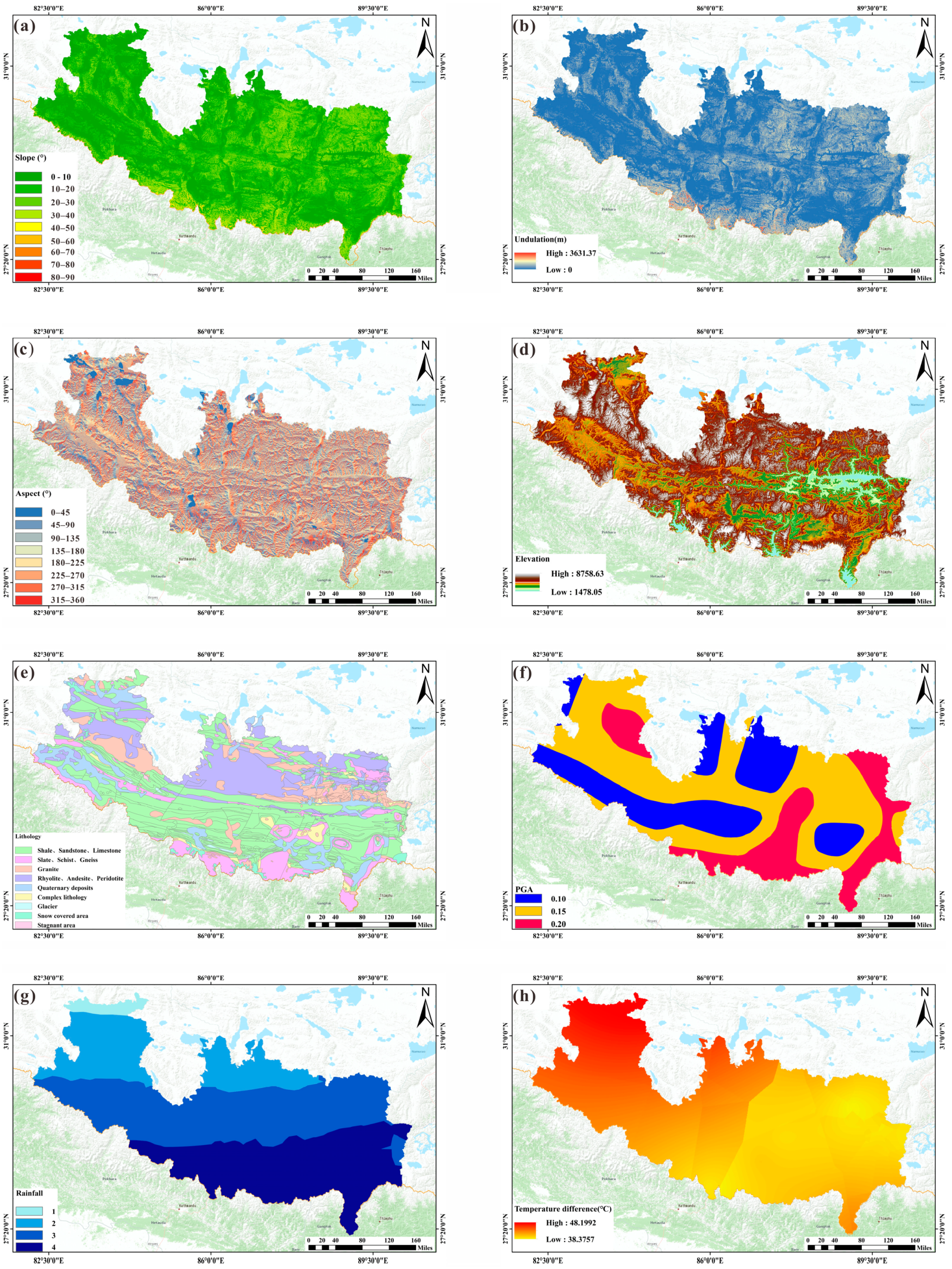
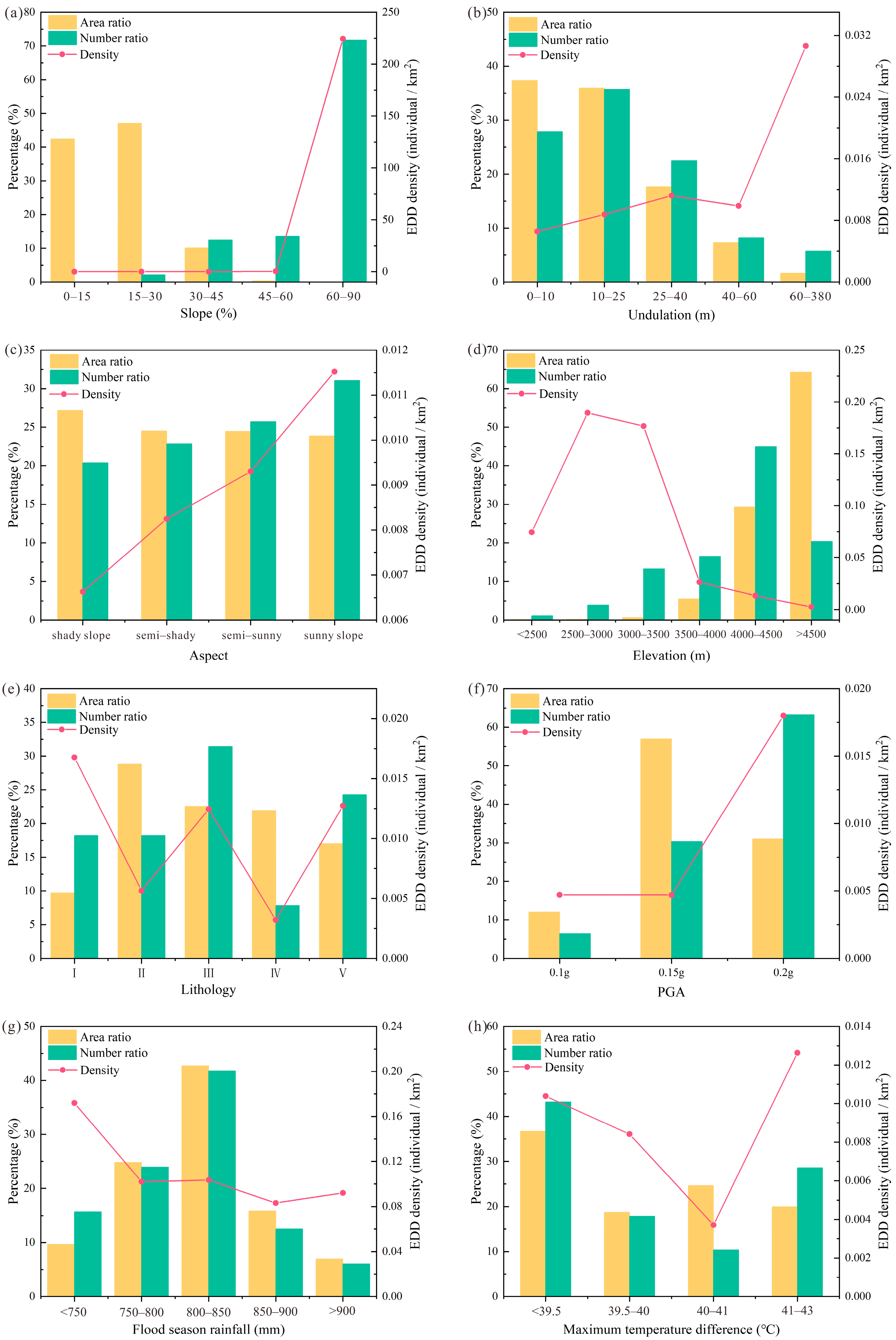


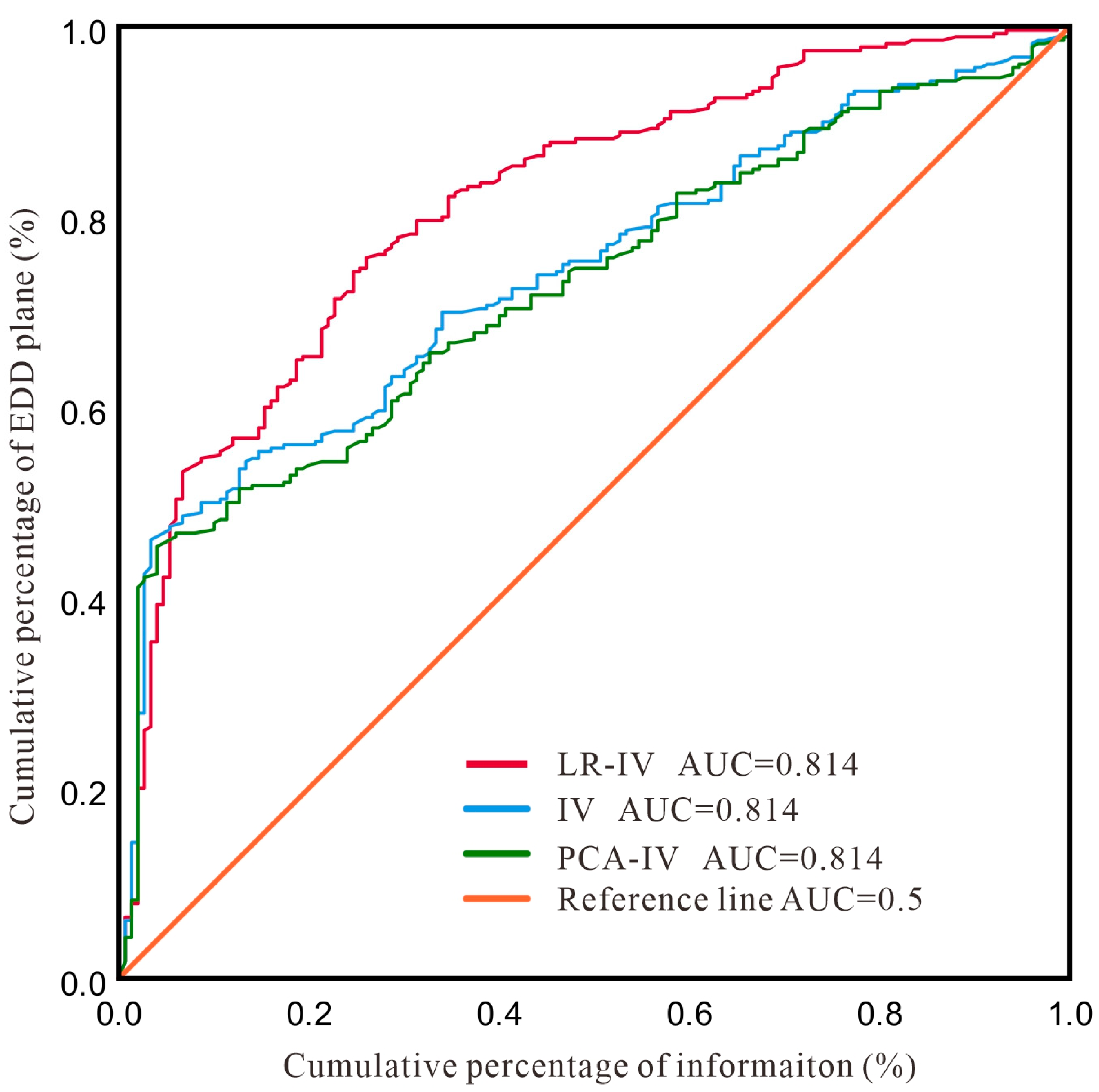
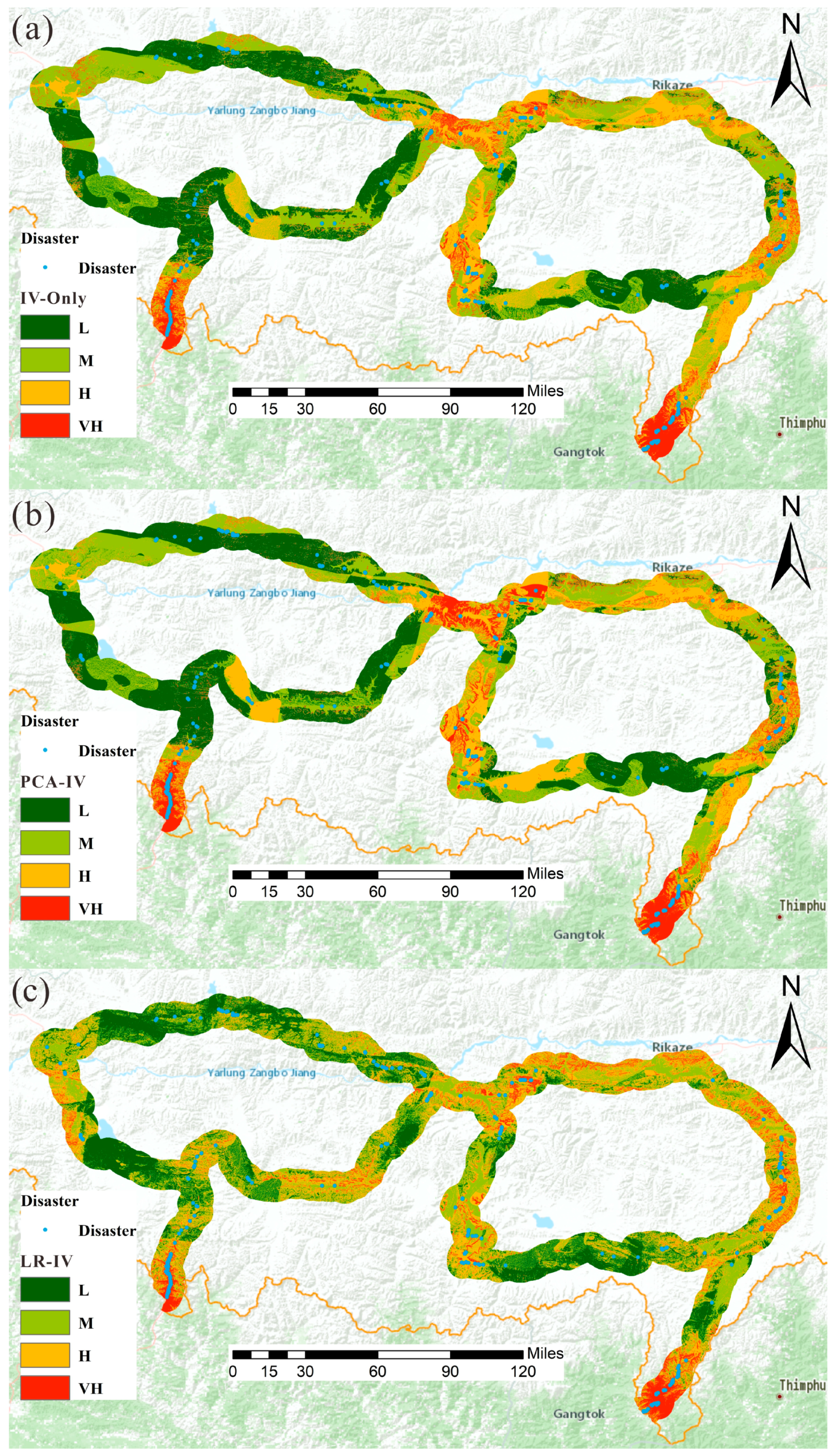
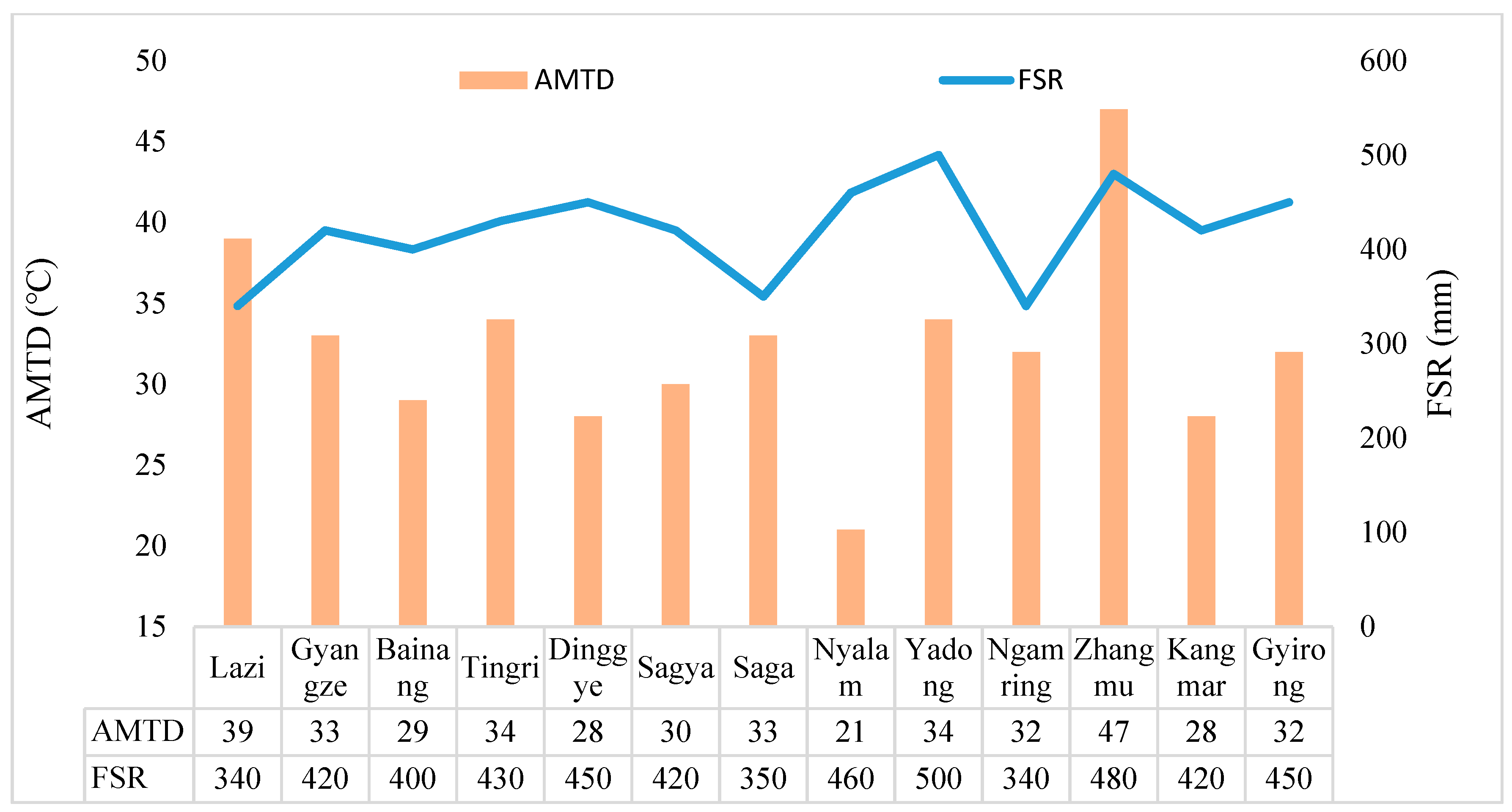
| Correlation Coefficient | |||||||
|---|---|---|---|---|---|---|---|
| Aspect | Lithology | Undulation | Rainfall | Elevation | PGA | Slope | |
| Aspect | 1 | ||||||
| Lithology | 0.017 | 1 | |||||
| Undulation | 0.030 | 0.153 | 1 | ||||
| Rainfall | 0.15 | 0.199 | 0.097 | 1 | |||
| Elevation | −0.022 | 0.215 | 0.356 | 0.312 | 1 | ||
| PGA | 0.153 | 0.498 | 0.198 | 0.247 | 0.414 | 1 | |
| Slope | 0.004 | 0.058 | 0.387 | 0.044 | 0.302 | 0.132 | 1 |
| Parameters | Component 1 | Component 2 |
|---|---|---|
| Eigenvalue | 2.602 | 1.528 |
| Contribution rates (%) | 31.172 | 21.835 |
| Rainfall | 0.406 | 0.327 |
| Undulation | 0.665 | −0.625 |
| Aspect | 0.601 | −0.723 |
| Lithology | 0.624 | 0.470 |
| PGA | 0.722 | 0.391 |
| Elevation | 0.825 | 0.240 |
| Aspect | −0.205 | 0.277 |
| Factor | Category | IV | PCA-IV | LR-IV | Factor | Category | IV | PCA-IV | LR-IV |
|---|---|---|---|---|---|---|---|---|---|
| Slope (°) | <5 | −4.00 | −0.61 | −0.33 | Undulation (m) | 0–10 | −0.42 | −0.06 | −0.98 |
| 5–15 | −4.00 | −0.61 | −0.33 | 10–25 | −0.01 | 0.00 | −0.02 | ||
| 15–30 | −3.88 | −0.59 | −0.32 | 25–40 | 0.35 | 0.05 | 0.81 | ||
| 30–40 | −0.60 | −0.09 | −0.05 | 40–60 | 0.16 | 0.02 | 0.38 | ||
| 40–90 | 5.28 | 0.80 | 0.43 | 60–380 | 1.80 | 0.27 | 4.17 | ||
| Lithology | I | 0.91 | 0.23 | −0.45 | Elevation (m) | <2500 | 3.08 | 0.55 | 1.43 |
| II | −0.66 | −0.17 | 0.33 | 2500–3000 | 4.43 | 0.80 | 2.06 | ||
| III | 0.48 | 0.12 | −0.24 | 3000–3500 | 4.32 | 0.78 | 2.02 | ||
| IV | −1.48 | −0.38 | 0.73 | 3500–4000 | 1.58 | 0.28 | 0.74 | ||
| V | 0.51 | 0.13 | −0.25 | 4000–4500 | 0.62 | 0.11 | 0.29 | ||
| PGA | 0.10 | −0.90 | −0.13 | −0.25 | >4500 | −1.66 | −0.30 | −0.77 | |
| 0.15 | −0.91 | −0.13 | −0.26 | Aspect | <45° | −0.45 | −0.02 | −0.23 | |
| 0.20 | 1.03 | 0.15 | 0.29 | 45°–135° | 0.07 | 0.00 | 0.04 | ||
| Rainfall (mm) | <750 | 0.70 | 0.06 | 0.49 | 135°–225° | 0.38 | 0.01 | 0.20 | |
| 750–800 | −0.05 | 0.00 | −0.04 | 225°–315° | −0.10 | 0.00 | −0.05 | ||
| 800–850 | −0.03 | 0.00 | −0.02 | 315°–360° | −0.38 | −0.01 | −0.20 | ||
| 850–900 | −0.35 | −0.03 | −0.24 | ||||||
| >900 | −0.20 | −0.02 | −0.14 |
| Weight of Factor | Slope | Elevation | Aspect | PGA | Rainfall | Lithology | Undulation |
|---|---|---|---|---|---|---|---|
| PCA | 0.152 | 0.180 | 0.034 | 0.147 | 0.080 | 0.257 | 0.151 |
| LR | 2.322 | 0.466 | 0.518 | 0.281 | 0.699 | −0.493 | 0.082 |
| Classification | IV-Only | LR-IV | PCA-IV |
|---|---|---|---|
| low | 0.436655 | 0.339742 | 0.406898 |
| moderate | 0.437352 | 0.410611 | 0.427596 |
| high | 1.009406 | 0.852367 | 0.73273 |
| very high | 4.753016 | 6.017837 | 4.786726 |
Disclaimer/Publisher’s Note: The statements, opinions and data contained in all publications are solely those of the individual author(s) and contributor(s) and not of MDPI and/or the editor(s). MDPI and/or the editor(s) disclaim responsibility for any injury to people or property resulting from any ideas, methods, instructions or products referred to in the content. |
© 2023 by the authors. Licensee MDPI, Basel, Switzerland. This article is an open access article distributed under the terms and conditions of the Creative Commons Attribution (CC BY) license (https://creativecommons.org/licenses/by/4.0/).
Share and Cite
Song, Y.; Guo, J.; Ma, F.; Liu, J.; Li, G. Improving the Accuracy of Regional Engineering Disturbance Disaster Susceptibility by Optimizing Weight Calculation Methods—A Case Study in the Himalayan Area, China. Sustainability 2023, 15, 10669. https://doi.org/10.3390/su151310669
Song Y, Guo J, Ma F, Liu J, Li G. Improving the Accuracy of Regional Engineering Disturbance Disaster Susceptibility by Optimizing Weight Calculation Methods—A Case Study in the Himalayan Area, China. Sustainability. 2023; 15(13):10669. https://doi.org/10.3390/su151310669
Chicago/Turabian StyleSong, Yewei, Jie Guo, Fengshan Ma, Jia Liu, and Guang Li. 2023. "Improving the Accuracy of Regional Engineering Disturbance Disaster Susceptibility by Optimizing Weight Calculation Methods—A Case Study in the Himalayan Area, China" Sustainability 15, no. 13: 10669. https://doi.org/10.3390/su151310669
APA StyleSong, Y., Guo, J., Ma, F., Liu, J., & Li, G. (2023). Improving the Accuracy of Regional Engineering Disturbance Disaster Susceptibility by Optimizing Weight Calculation Methods—A Case Study in the Himalayan Area, China. Sustainability, 15(13), 10669. https://doi.org/10.3390/su151310669








